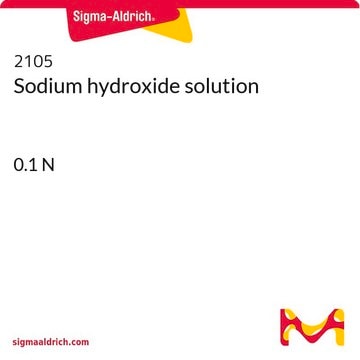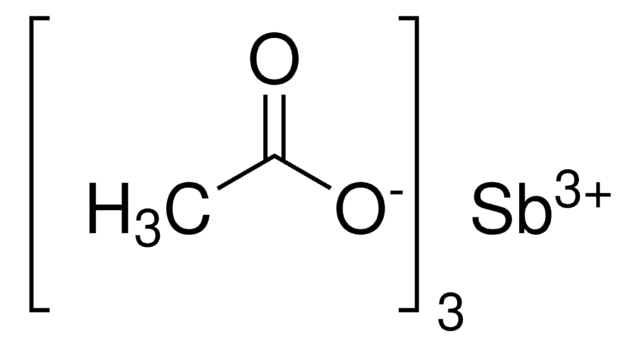938998
Sodium hydroxide ChemBeads

Sinónimos:
Caustic soda ChemBeads
Iniciar sesiónpara Ver la Fijación de precios por contrato y de la organización
About This Item
Fórmula empírica (notación de Hill):
NaHO
Número de CAS:
Peso molecular:
40.00
Número MDL:
Código UNSPSC:
12352100
Productos recomendados
descripción
Reagent Type: Inorganic salt
Nivel de calidad
formulario
solid
composición
loading of base, 14-16 wt. %
idoneidad de la reacción
core: sodium
cadena SMILES
[OH-].[Na+]
Descripción general
Sodium hydroxide, also known as lye and caustic soda, is a strong base used universally as a neutralization agent in the chemical industry, paper making, petroleum refining, cleaning compounds, and drain cleaners.
Aplicación
Sodium hydroxide can be used as:
A reagent in the gold-catalyzed selective oxidation of glycerol to glyceric acid. A catalyst for the cross-dehydrogenative coupling of alcohols and hydrosilanes to synthesize silyl ethers.
A base in the Sonogashira-type coupling of aryl halides and alkynes to synthesize ynones.
For general uses, product is also available in powdered form(655104)
A reagent in the gold-catalyzed selective oxidation of glycerol to glyceric acid. A catalyst for the cross-dehydrogenative coupling of alcohols and hydrosilanes to synthesize silyl ethers.
A base in the Sonogashira-type coupling of aryl halides and alkynes to synthesize ynones.
For general uses, product is also available in powdered form(655104)
Características y beneficios
ChemBeads are chemical coated glass beads. ChemBeads offer improved flowability and chemical uniformity perfect for automated solid dispensing and high-throughput experimentation. The method of creating ChemBeads uses no other chemicals or surfactants allowing the user to accurately dispense sub-milligram amounts of chemical.
Otras notas
High-Throughput Reaction Screening with Nanomoles of Solid Reagents Coated on Glass Beads
Versatile Methods to Dispense Sub-Milligram Quantities of Solids using Chemical Coated Beads for High-Throughput Experimentation
ChemBead Enabled High-Throughput Cross-Electrophile Coupling Reveals a New Complementary Ligand
Versatile Methods to Dispense Sub-Milligram Quantities of Solids using Chemical Coated Beads for High-Throughput Experimentation
ChemBead Enabled High-Throughput Cross-Electrophile Coupling Reveals a New Complementary Ligand
Producto relacionado
Referencia del producto
Descripción
Precios
Palabra de señalización
Danger
Frases de peligro
Consejos de prudencia
Clasificaciones de peligro
Eye Dam. 1 - Met. Corr. 1 - Skin Corr. 1A
Código de clase de almacenamiento
8B - Non-combustible corrosive hazardous materials
Clase de riesgo para el agua (WGK)
WGK 3
Punto de inflamabilidad (°F)
Not applicable
Punto de inflamabilidad (°C)
Not applicable
Choose from one of the most recent versions:
Certificados de análisis (COA)
Lot/Batch Number
Don't see the Right Version?
If you require a particular version, you can look up a specific certificate by the Lot or Batch number.
¿Ya tiene este producto?
Encuentre la documentación para los productos que ha comprado recientemente en la Biblioteca de documentos.
Ana L Aguirre et al.
Chemistry (Weinheim an der Bergstrasse, Germany), 27(51), 12981-12986 (2021-07-08)
High-throughput experimentation (HTE) methods are central to modern medicinal chemistry. While many HTE approaches to C-N and Csp2 -Csp2 bonds are available, options for Csp2 -Csp3 bonds are limited. We report here how the adaptation of nickel-catalyzed cross-electrophile coupling of
Noah P Tu et al.
Angewandte Chemie (International ed. in English), 58(24), 7987-7991 (2019-03-21)
Technologies that enable rapid screening of diverse reaction conditions are of critical importance to methodology development and reaction optimization, especially when molecules of high complexity and scarcity are involved. The lack of a general solid dispensing method for chemical reagents
Barbara Simonato et al.
Food chemistry, 174, 219-225 (2014-12-23)
The aim of this study was to assess the digestibility of the protein and starch in pasta made with different cereals, i.e. Triticum durum, Triticum polonicum and Triticum dicoccum, and to measure the glycemic index (GI) of the different types
Mathieu André et al.
Organic & biomolecular chemistry, 13(2), 388-397 (2014-11-05)
In the development of our melanoma-selective delivery approach, three preselected conjugates of 5-iodo-2'-deoxyuridine (IUdR) to the ICF01012 melanoma-carrier were radiolabelled with iodine-125, and their in vivo distribution profile was determined. A radioiodination method for the conjugate 1a and its PEGylated
Qianli Zou et al.
Journal of medicinal chemistry, 58(20), 7949-7958 (2015-09-24)
A series of bis(arylidene)cycloalkanone photosensitizers modified by polyethylene glycol (PEG) have been studied for two-photon excited photodynamic therapy (2PE-PDT). As compared with their prototype compounds, these PEGylated photosensitizers show enhanced water solubilities while their photophysical and photochemical properties, including linear
Nuestro equipo de científicos tiene experiencia en todas las áreas de investigación: Ciencias de la vida, Ciencia de los materiales, Síntesis química, Cromatografía, Analítica y muchas otras.
Póngase en contacto con el Servicio técnico





